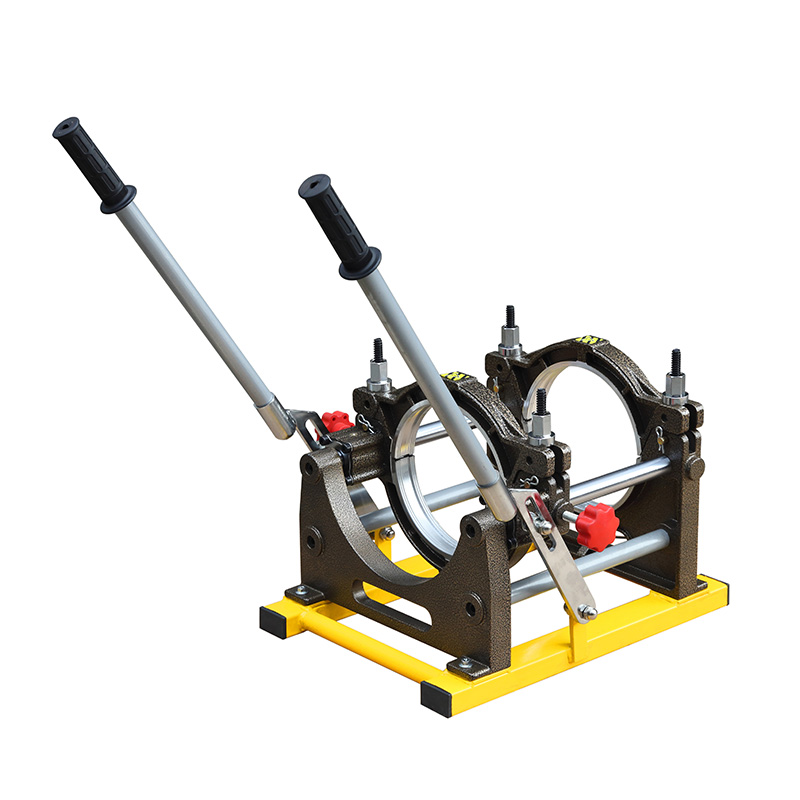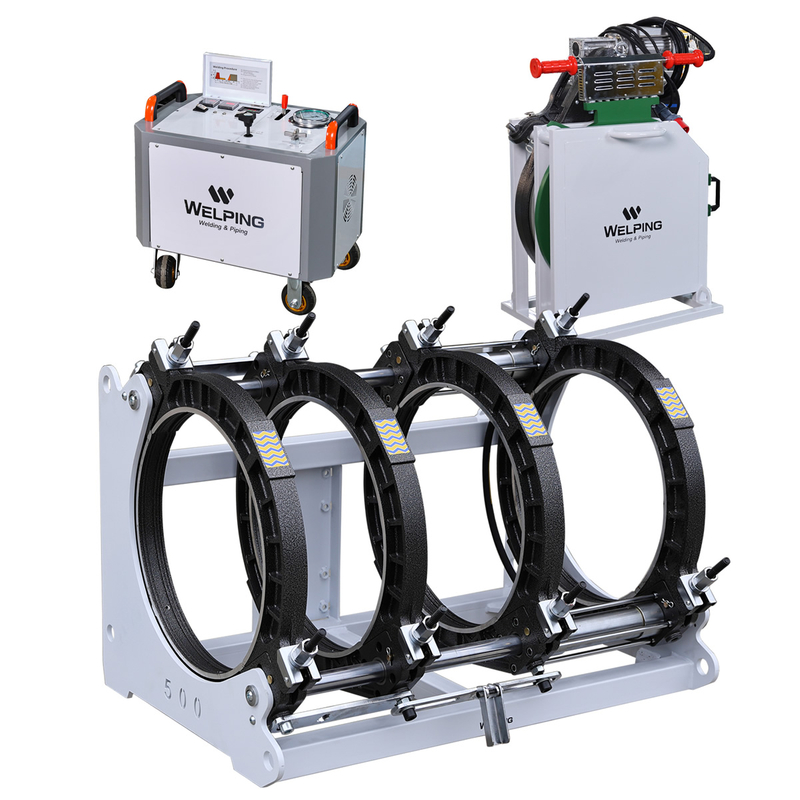Views: 0 Author: Site Editor Publish Time: 2025-09-30 Origin: Site









Choosing the right fusion machine can make or break your project. Manual models offer simplicity, while hydraulic butt fusion machines deliver precision. Both have strengths and weaknesses. In this article, you will learn their pros and cons to decide which option fits your project needs best.

Manual butt fusion machines are lightweight and easy to transport. Contractors often choose them for small repair jobs in remote areas. Their compact frames allow work where large equipment cannot fit, such as trenches or narrow sites. This mobility makes them a practical tool for emergency fixes.
One of the biggest draws of manual machines is affordability. They require a smaller upfront investment compared to hydraulic butt fusion machines. Spare parts are also cheaper and easier to replace. For small businesses or contractors handling limited workloads, this cost efficiency makes them an attractive choice.
These machines are simple to set up and operate. They do not rely on advanced digital controls or external power, making them accessible to less experienced operators. Minimal training is required, and users can often achieve acceptable welds after a short practice period. This simplicity allows quick deployment in field projects.
Despite their advantages, manual butt fusion machines struggle with precision. The weld quality depends heavily on the operator’s skill. Small mistakes in pressure or alignment can weaken the joint, increasing the chance of leaks. For critical pipelines, this inconsistency becomes a major drawback. Unlike hydraulic systems, they cannot guarantee uniform weld pressure every time.
Manual machines are not built for high-volume work. They can handle occasional welding but become inefficient for continuous projects. Throughput is slower, and operators tire quickly, which can affect consistency. Large-diameter pipes or municipal-scale projects usually demand the stability and efficiency of hydraulic butt fusion machines.
Factor | Manual Machines | Hydraulic Machines |
Portability | Lightweight, easy to transport | Heavier, less mobile |
Cost | Low upfront and maintenance costs | Higher initial and service expenses |
Precision | Operator-dependent, variable | Consistent, automated pressure control |
Suitability | Small repairs, short projects | Large pipelines, critical infrastructure |
Training | Minimal learning curve | Requires skilled operation |

Hydraulic butt fusion machines excel at producing strong, uniform joints. Their hydraulic systems apply steady pressure, reducing human error. This control ensures joints remain leak-proof and durable, even in high-pressure pipelines. For industries like gas or water supply, this level of consistency is vital for safety and long-term performance.
These machines significantly improve project speed. Automated pressure control and heating cycles shorten weld times. Crews can complete more joints in less time, which reduces labor costs and downtime. For large-diameter pipes or municipal pipelines, faster throughput translates to real savings.
Modern hydraulic butt fusion machines often include digital displays and programmable settings. Operators can set exact heating times and pressure levels, improving accuracy. Automated temperature regulation also helps maintain weld quality in changing site conditions. These features reduce rework and improve efficiency.
Hydraulic systems are not limited to one sector. They are widely used in water treatment, gas distribution, mining, and municipal projects. Their ability to handle different pipe sizes and materials makes them highly adaptable. Contractors working across multiple industries benefit from this versatility.
Unlike adhesive-based methods, hydraulic welding avoids harmful chemicals. The joints are corrosion-resistant and withstand harsh environments, including sewage or chemical pipelines. Consistent weld strength reduces the risk of leaks that could harm ecosystems or public health. This makes them a sustainable choice for critical infrastructure.
Advanced components and digital controls make these machines more expensive. Maintenance costs are also higher, since hydraulic systems require regular servicing. Spare parts can be costly, and downtime may be longer if complex repairs are needed. For smaller contractors, this cost barrier can be significant.
Hydraulic machines are larger and heavier than manual models, making them harder to transport. They also demand trained operators who understand pressure control and digital settings. Without training, weld quality and safety can suffer. Companies often invest in staff training programs to maximize machine benefits.
Factor | Advantages | Drawbacks |
Welding Precision | Consistent, leak-proof joints | Requires skilled operators |
Productivity | Faster cycles, higher throughput | Higher energy use |
Features | Digital displays, automated heating | More complex maintenance |
Industry Applications | Water, gas, mining, municipal systems | Limited portability |
Safety & Sustainability | No adhesives, corrosion-resistant joints | Cost barrier for smaller projects |
Manual butt fusion machines are a practical choice for teams working under tight budgets. Their purchase price is significantly lower than hydraulic models, and spare parts are affordable. Maintenance is simpler, often handled on-site without specialized technicians. For contractors handling small water connections or occasional repairs, this cost advantage makes them attractive. However, the savings may be offset if rework is needed due to inconsistent weld quality.
While hydraulic butt fusion machines require higher initial investment, they deliver better value over time. Their automated systems improve precision, which reduces rework and material waste. They also boost productivity, allowing crews to complete more joints per shift. This efficiency lowers labor costs in large infrastructure projects. For companies planning long-term pipeline contracts, the reliability of hydraulic machines often outweighs their higher purchase price.
The decision depends on project scale and frequency. Small firms or short-term projects may find manual machines sufficient. Yet, for large-scale operations where deadlines and safety are critical, hydraulic machines offer lower lifetime costs despite their higher price tag. Considering energy use, labor hours, and reduced downtime, the total cost of ownership often favors hydraulic systems in the long run.
Factor | Manual Machines | Hydraulic Machines |
Purchase Price | Low, budget-friendly | High, major upfront investment |
Spare Parts | Affordable, easy to source | More expensive, specialized |
Maintenance | Simple, handled on-site | Requires skilled service |
Long-Term Reliability | Inconsistent, operator-dependent | Consistent, less rework needed |
Best Fit | Small jobs, limited budgets | Large projects, frequent use |
Manual butt fusion machines are straightforward. Operators can often learn the basics within a single day. They use simple clamps and heating plates, requiring little more than attention to alignment and timing. For crews handling occasional welding, this ease of use reduces training costs. Smaller contractors value this simplicity because it allows quick deployment without specialized staff.
In comparison, hydraulic butt fusion machines require more technical knowledge. Operators must understand how to set and monitor pressure, manage digital temperature controls, and adjust automated systems. Without training, weld quality can drop, leading to costly rework. Many companies invest in certification programs to ensure operators handle these machines correctly. Proper training not only improves efficiency but also extends the lifespan of the equipment.
Both manual and hydraulic machines benefit from regular preventive checks. Manual models usually need basic cleaning and visual inspections. Hydraulic systems, however, involve pumps, hoses, and digital modules that require skilled servicing. If neglected, downtime can be longer and repairs more expensive. Planned maintenance schedules help minimize project delays and ensure consistent performance across job sites.
Ease of Use and Training Snapshot
Factor | Manual Machines | Hydraulic Machines |
Learning Curve | Quick, minimal training needed | Requires specialized training |
Operation Simplicity | Direct, hands-on control | Automated systems, digital settings |
Maintenance Complexity | Basic cleaning and checks | Advanced servicing, longer downtime |
Best Fit | Small teams, occasional projects | Skilled teams, large-scale projects |
Note: Training costs may seem high, but for firms using hydraulic butt fusion machines on critical infrastructure, they reduce long-term risks and improve client trust.
Manual butt fusion machines shine when portability is key. Their lightweight frames make them easy to carry across rough terrain or into narrow spaces. For quick pipe repairs or short runs in remote villages, these machines are reliable. Contractors often use them for emergency water line fixes or temporary connections where mobility outweighs speed.
In contrast, hydraulic butt fusion machines deliver the power and consistency required for heavy-duty tasks. Their ability to maintain uniform weld pressure makes them the preferred option for pipelines stretching over kilometers. When projects demand tight deadlines and high safety standards, their faster throughput and reduced error rates become essential. Large-diameter gas pipelines or city water distribution networks benefit most from their precision and speed.
Hydraulic systems dominate in industries that require durable, long-lasting joints:
● Water Pipelines: Strong, leak-proof welds ensure safe drinking water distribution.
● Gas Distribution: Consistent joints prevent leaks that could risk safety.
● Mining Pipelines: Abrasion-resistant welds hold up in extreme conditions.
● Sewage Systems: Corrosion-resistant joints withstand harsh chemical exposure.
Manual machines, however, remain useful in specific niches. Small contractors, rural infrastructure projects, and temporary installations often rely on their flexibility. The choice ultimately depends on balancing project size, budget, and expected pipeline lifespan.
Project Type | Best Choice | Reason |
Short repairs, remote jobs | Manual machine | Portable, quick setup |
Municipal water projects | Hydraulic machine | Durable joints, faster throughput |
Gas distribution pipelines | Hydraulic machine | Safety-critical precision |
Mining and sewage systems | Hydraulic machine | Resistant to abrasion and chemicals |
Low-budget small projects | Manual machine | Affordable and easy to maintain |
When evaluating manual and hydraulic butt fusion machines, four factors dominate: precision, productivity, portability, and cost. Manual models are light and affordable but depend on operator skill for joint quality. Hydraulic systems deliver consistent welds with less human error. They also complete joints faster, making them ideal for large pipelines. However, their size and price can be barriers for smaller contractors.
Factor | Manual Machines | Hydraulic Butt Fusion Machines |
Precision | Operator-dependent, variable results | Automated pressure control, consistent |
Productivity | Slower cycles, fewer joints per shift | Faster throughput, better efficiency |
Portability | Lightweight, field-friendly | Heavy, best for fixed or large projects |
Cost | Low upfront, minimal parts expense | High purchase price, higher maintenance |
Manual machines place nearly all responsibility on the operator. Small mistakes in heating or pressure can cause failed welds. They require steady hands and careful attention. In contrast, hydraulic butt fusion machines automate many steps. Digital displays, timers, and regulated pressure systems reduce the chance of errors. This automation allows less experienced staff to achieve consistent results once trained. The trade-off is complexity—hydraulic models demand more technical understanding and structured training.
Manual machines are best for:
● Small-scale repairs in remote areas.
● Budget-limited contractors handling short-term projects.
● Jobs where portability matters more than speed.
Hydraulic machines are best for:
● Large-scale water or gas pipelines requiring high precision.
● Projects with strict deadlines where throughput matters.
● Industries like mining or sewage where durability is critical.
The decision often comes down to project frequency and client expectations. Occasional use favors manual tools. Long-term contracts with municipalities or utilities justify the investment in hydraulic machines.
Manual machines are affordable and portable, fitting small repair projects. Hydraulic butt fusion machines offer speed and precision, ideal for large infrastructure. The right choice depends on budget, project scale, and quality goals. Welping provides advanced machines designed for durability and efficiency, helping businesses achieve consistent welds while reducing downtime. Their products combine precision technology with reliable service, making them a strong partner for demanding pipeline projects.
A: Hydraulic butt fusion machines provide precise, consistent joints and higher productivity, making them ideal for large-scale projects.
A: Manual machines suit small, low-budget, or remote jobs, while hydraulic butt fusion machines fit high-volume, demanding applications.
A: Yes, their automation reduces rework and labor costs, offering better long-term value for infrastructure projects.
A: Yes, operators must understand pressure settings and digital controls to ensure safe, accurate welds.
